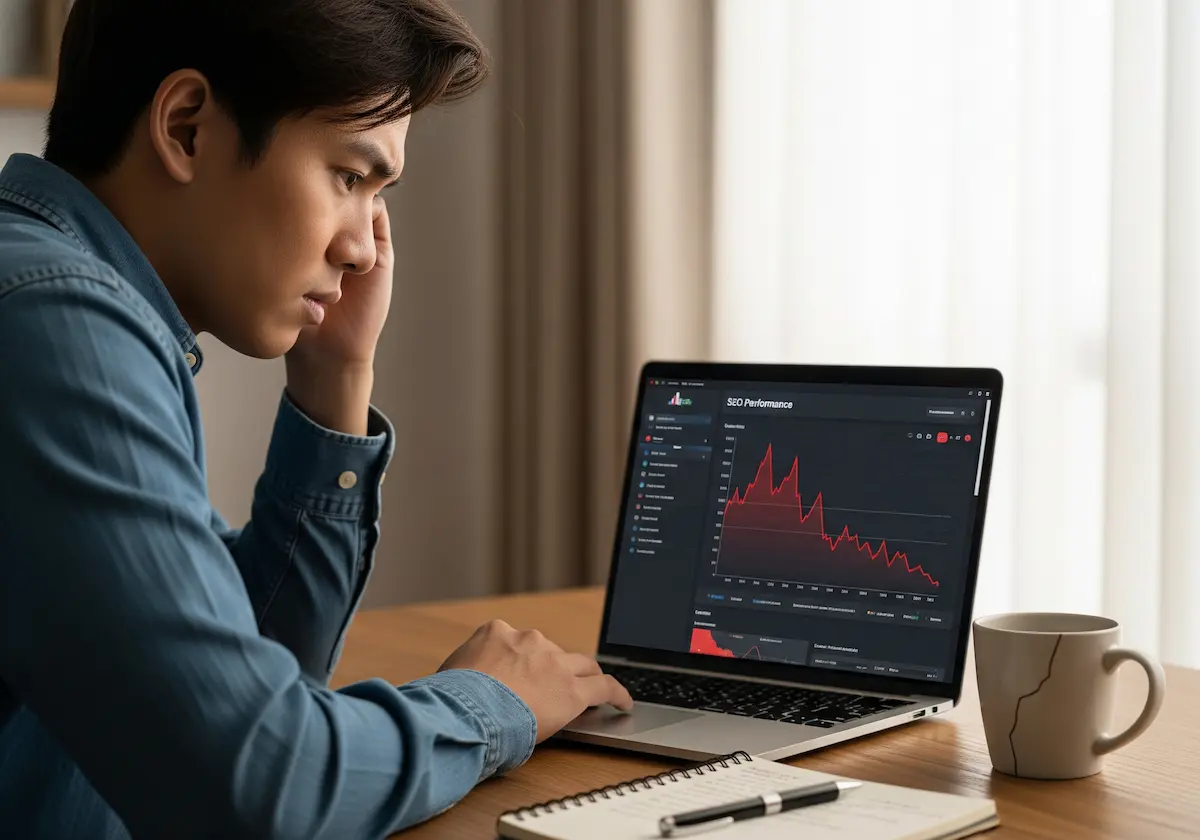Why Your SEO Strategy Might Be Sabotaging Your Success
Every day, website owners pour hours into SEO strategies that backfire. They’re following outdated advice and using tactics that worked five years ago, but now trigger algorithmic red flags from search engines and may even result in penalties
If your organic traffic has plateaued despite your best efforts, you’re probably making one of these ranking mistakes.
However, what most people don’t realize is that fixing these SEO mistakes often produces faster results than implementing new strategies.
In this guide, we’re revealing the SEO mistakes still haunting websites in 2025. You’ll learn exactly what’s hurting your search results and how to fix it fast, plus the simple tweaks that can boost your visibility immediately.
Time to stop working against yourself and start working with Google’s algorithm instead.
Keyword Stuffing: The Outdated Tactic That Backfires
Most website owners think they’re being smart by cramming their target keywords into every paragraph. This couldn’t be further from the truth. Search engines have evolved far beyond simple keyword matching, and they can easily detect when you’re forcing keywords where they don’t belong.
If you’ve ever wondered why your over-optimized pages aren’t ranking, keyword stuffing might be the common SEO mistake you never considered.

How Google Detects Unnatural Keyword Density
Google uses semantic analysis to understand context and meaning. When you repeat “best pizza restaurant” fifteen times in a 300-word article, the algorithm recognizes this as manipulation.
Drawing from our experience, pages with keyword densities above 3% often see ranking drops within weeks. The interesting part is that modern search engines focus on search intent rather than exact keyword matches, which makes natural language far more valuable than forced repetition.
Real Examples of Keyword Stuffing Gone Wrong
Consider this actual meta description we found: “Best dentist Chicago, Chicago dentist, dental services Chicago, Chicago dental office.” Not only does this sound terrible to readers, but it also signals to Google that you’re trying to game the system.
This type of keyword stuffing confuses search engines and creates a poor user experience that hurts your Google search results.
Proven Natural Keyword Integration Method
Instead of forcing keywords, focus on answering your audience’s questions naturally. Use related terms and synonyms that flow with your content.
This approach satisfies both readers and search engines while improving your overall SEO strategy. But keyword stuffing isn’t the only technical issue that can tank your rankings. Broken links are also serious threat that most site owners completely overlook.
Broken Links: The Ranking Killers
Nothing frustrates users more than clicking a link and landing on a 404 error page. In this circumstance, the culprit here is nothing but broken links. Such links not only annoy your visitors, but also they’re secretly destroying your SEO performance.
When search engine crawlers encounter broken links, they interpret this as a sign of poor website maintenance and outdated content.
Here’s what you need to know about the different types of broken links and how to eliminate them quickly:
- Internal links: They create dead ends that prevent Google from crawling your site effectively, reducing your overall indexation. Think of them as roadblocks that stop search engines from discovering your best content.
- External broken links: Usually, these links damage your credibility and waste the SEO value you’re trying to pass to other sites. When you link to a page that no longer exists, you’re essentially vouching for content that isn’t there.
- Detection tools: There are some renowned tools, like Screaming Frog and Ahrefs can quickly identify broken links across your entire website in minutes. These tools crawl your site just like Google does, spotting problems before they hurt your rankings.
- Quick fixes: These include updating URLs, removing dead links, or redirecting broken pages to relevant content. The key is acting fast once you’ve identified the issues.
Based on our observations, websites with more than 10 broken links per 100 web pages see a 15% drop in organic traffic within three months. You can easily monitor these SEO issues through Google Search Console, which alerts you to crawl errors and indexing problems.
Though the solution is simple, it requires regular monitoring. Now that we’ve covered the technical damage broken links cause, let’s explore how duplicate content creates an entirely different kind of ranking problem.
Duplicate Content Disasters Across Your Site
Here’s something that surprises most website owners: Google doesn’t penalize duplicate content the way people think. Instead, it creates a much worse problem. When you have multiple pages with identical content, Google picks one to show in search results and ignores the rest.
According to Moz research, duplicate content issues affect 29% of websites and can reduce overall search visibility by up to 50%. Imagine spending months optimizing five different pages, only to have Google show just one of them. That’s the duplicate content trap.

When duplicate content refers to identical or substantially similar content appearing on multiple pages, it confuses search engines about which version to prioritize. This creates a cannibalization effect where your same content competes against itself instead of dominating search results.
The fix involves either consolidating similar pages or using canonical tags to tell Google which version you want to rank.
In such a case, our suggestion is pretty simple: don’t let your content compete against itself. But if you think duplicate content is confusing, wait until you see how local SEO blunders can completely derail your customer acquisition efforts.
Local SEO Blunders That Cost You Customers
Local searches drive 78% of mobile commerce, yet most businesses sabotage their local SEO rankings without realizing it. The smallest inconsistencies can tank your visibility when potential customers are searching for your services on mobile devices.
Our client Mikadum’s restaurant saw a 40% drop in foot traffic after inconsistent business hours across directories confused potential customers. The problem often starts with basic NAP (Name, Address, Phone) inconsistencies across your online listings.
Here’s how the most common local SEO mistakes stack up against best practices:
|
Correct Practice |
Common Mistake |
|
Consistent business name everywhere |
“Mike’s Pizza” vs “Mike’s Pizza Restaurant” |
|
Identical address formatting |
“123 Main St” vs “123 Main Street” |
|
Same phone number across platforms |
Different numbers on Google vs Yelp |
|
Updated business hours everywhere |
Hours correct on Google, wrong on Facebook |
Google My Business optimization mistakes compound these problems. Many businesses claim their listing but never optimize it with photos, review responses, or regular posts.
This signals to search engines that your business isn’t actively maintained, which directly impacts how you appear in Google search results. The fix requires auditing every directory where your business appears and standardizing your information.
Now that we’ve covered how local inconsistencies hurt your visibility, let’s examine how poor alt text and anchor text practices waste valuable SEO opportunities.
Alt Text and Anchor Text Oversights
Your images and links are goldmines for SEO improvement, but most websites waste this opportunity. Through our hands-on experience auditing hundreds of sites, we’ve found that proper alt text and anchor text optimization can boost organic traffic by 25% or more.
These elements work harder than you think, serving both accessibility and SEO purposes simultaneously. When optimized correctly, they help search engines understand your content while making your site more user-friendly for screen readers and assistive technologies.
Let’s break down the two main areas where websites miss out on easy ranking wins:
Descriptive Alt Text That Boosts Image Rankings
Search Engine Journal research shows that proper alt text optimization can significantly increase image search visibility. Instead of “image1.jpg” or generic descriptions, use specific, descriptive alt text that explains what’s actually in the image.
- Bad example: “product image”
- Good example: “black leather office chair with adjustable armrests and lumbar support”
Anchor Text Mistakes That Confuse Google
Stop using “click here” or “read more” as your anchor text. These phrases tell search engines nothing about your linked content. Instead, use descriptive phrases that naturally incorporate relevant keywords and preview what users will find.
So, What are The Best Practices for Both in 2025?
Balance is everything when it comes to optimization. Your descriptive text should be descriptive enough to paint a clear picture, but avoid cramming it with keywords just for SEO purposes. Similarly, your anchor text needs to sound natural while still being informative about the destination content. The golden rule? Focus on helping users understand exactly what they’ll find when they click a link or what they’re looking at in your images.
While these technical optimizations improve your site’s foundation, there’s another problem that can completely undermine your SEO efforts: keyword cannibalization.
Keyword Cannibalization: When Your Pages Fight Each Other
Keyword cannibalization happens when multiple pages on your site target the same keywords and compete against each other in search results. It’s like having two employees applying for the same promotion, but nobody wins.
As a result, Google gets confused about which page should rank for your target keywords, so it often chooses neither. You know what’s the worst part? It dilutes your SEO efforts and wastes the authority you’ve built across your site.
The problem usually starts innocently. You write a blog post about “email marketing tips,” then create a service page for “email marketing services,” and later add a landing page for “email marketing solutions.” Before you know it, all three pages end up competing for the same keyword.
To identify keyword cannibalization, you’ll need to analyze your current rankings. We recommend that you use some effective tools. For example, you can use tools like Google Search Console to see if multiple pages rank for the same queries. Also, look for pages that fluctuate in rankings, which often indicates cannibalization issues affecting your search results.

Once you’ve identified the problem, the fix involves consolidating similar content or differentiating your pages. Merge weak pages into stronger ones, or rewrite content to target distinct keywords.
However, prevention is simpler than fixing existing problems. So, create a content strategy that maps specific keywords to individual pages.
Before publishing new content, check that you’re not targeting keywords already covered on your site. This systematic approach prevents future cannibalization while strengthening your overall SEO performance.
Frequently Asked Questions
After helping hundreds of clients fix these exact problems, we get the same questions repeatedly. Here are the answers to what you’re probably wondering:
How often should I audit for these SEO mistakes?
Run a comprehensive audit every three months, but check for broken links and common SEO issues monthly. Technical SEO problems can develop quickly, especially after site updates or content changes.
Can fixing these issues improve rankings quickly?
Yes! Broken links and duplicate content fixes often show results within 2-4 weeks. Local SEO corrections and anchor text improvements typically take 4-6 weeks to impact search results.
What’s the most damaging SEO mistake for small businesses?
Local SEO inconsistencies hurt small businesses the most because they rely heavily on local search traffic. Inconsistent NAP information can immediately impact your visibility in Google search results.
Do these mistakes affect mobile sites differently?
Mobile optimization amplifies these problems. Broken links frustrate mobile users more, and local SEO errors have bigger consequences since mobile devices drive most local searches.
Your Next Steps to Cleaner SEO
Look, we get it. SEO can feel like a never-ending battle, and discovering you’ve been making these mistakes probably stings a little. But the consolation for you is that every website owner has been there.
You don’t need to tackle everything at once, for sure. Pick one or two issues that resonated with you most and start there. Maybe it’s those broken links you’ve been ignoring, or perhaps you finally want to clean up that keyword-stuffed content. Small wins build momentum, and momentum builds better rankings.
Think of this as your SEO reality check, not a punishment. Now you know what’s been holding you back, which honestly puts you ahead of most website owners who are still stumbling in the dark.
At Click2Rank, we’ve walked countless business owners through these exact fixes. We have seen the feeling of relief on their faces when rankings start climbing again. It’s completely satisfying. That’s why we do this work. So, don’t hesitate to contact us if you’re on the same boat.



